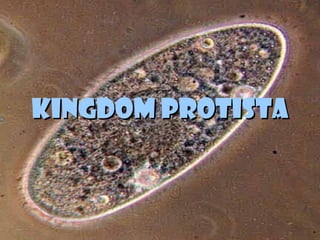
Kingdom protista
- 2. General Characteristics Protists are very diverse and have few traits in common Most are single-celled organisms, but some are many cells, and others live in colonies Some produce own food, others eat other organisms or decaying matter Some can control own movement, others cannot
- 3. Characteristics that protists DO share: Eukaryotic(have a nucleus), but are less complex than other eukaryotic organisms Do not have specialized tissues Members of the kingdom Protista are related more by how they differ from members of other kingdoms than by how they are similar to other protists
- 4. zooflagellates Protists have many different shapes Pretzel slime Most scientists mold ulva agree that fungi, plants, and animals evolved from early protists Paramecium
- 5. Protists and Food Protists can get food many ways: Can make own food Can eat other organisms Can eat parts or products of other organisms Can eat remains of other organisms Some use more than one way to get food Some produce food—they use chloroplasts to produce food through photosynthesis
- 6. Finding Food Heterotroph: organism that cannot make own food Some are decomposers—they get energy by breaking down dead organic matter
- 7. Asexual Reproduction Most protists reproduce asexually Offspring come from just one parent Binary fission: a single-celled protist divides into two cells Each new cell is a single-celled protist
- 8. Sexual Reproduction Requires two parents Paramecium sometimes reproduce sexually by a process called conjugation
- 9. Algae Kinds of Protists Allalgae have the green pigment chlorophyll, which is used to make food through photosynthesis Almost all algae live in water Free-floating, single- celled algae are called phytoplankton, which produce much of the world’s oxygen
- 10. Amoebas Soft,jellylike protozoans Found in fresh and salt water, soil, and in parasites Move with pseudopodia, which means “false feet”
- 11. Ciliates Have hundreds of cilia— tiny, hairlike structures Cilia move the protist forward by beating back and forth—sometimes up to 60 times a second! Cilia are also used for feeding—they move the food towards the protist’s food passageway Best known of ciliates is the Paramecium
- 12. Spore-Forming Protists Many spore-forming protists are parasites They absorb nutrients from their hosts No cilia or flagella, cannot move on their own Have complicated life cycles that usually includes two or more hosts Example: protist that causes malaria uses both mosquitoes and humans as hosts
- 13. Slime Molds Heterotrophic and can only move during certain periods of life cycle Look like thin, colorful globs of slime Use pseudopodia to move and eat fungi and yeast When environmental conditions are stressful, slime molds grow stalks with knobs, which contain spores
- 14. Red Algae Most of world’s seaweed is red algae Most live in tropical oceans Usually less than 1 m in length Contain chlorophyll, but have red pigment Red pigment allows them to absorb light that filters deep into ocean
- 15. Brown algae Most seaweed in cool climates are brown algae Attach to rocks or form large floating beds in ocean waters Have chlorophyll and yellow-brown pigment Many are very large—up to 60 meters
- 16. Green algae Most diverse of protist producers Green because chlorophyll is main pigment Most live in water or moist soil Others live in melting snow, on tree trunks, and inside other organisms
- 17. Diatoms Single-celled Found in salt and fresh water Get energy from photosynthesis Make up a large percentage of phytoplankton Cell walls contain a glasslike substance called silica